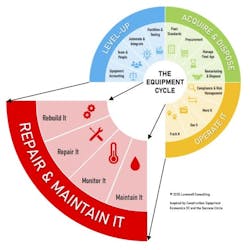Key Highlights
In this article, you will learn:
- How to reduce unplanned failures.
- How to assess equipment health.
- How to properly handle equipment repair.
- How to ensure equipment reliability.
The Equipment Cycle maps out the four core activities of running equipment: acquire and dispose; operate it; repair and maintain it; and continuous improvement. In Part 3 of our series explaining the cycle, we turn to Repair & Maintain It, which is focused on keeping machines running, reducing downtime, preventing breakdowns, and making sure equipment is always ready to work.
When equipment keeps breaking down, it’s easy to think the solution is hiring more mechanics; but most problems don’t start in the shop, they end up there. Breakdowns often happen because maintenance was delayed, small issues were missed, or machines were pushed too hard without the right checks in place. More people might help short term, but without a strong plan, the problems just keep coming back.
Repair and maintenance is the largest cost a company will face after buying the equipment, so every dollar needs to count. The key isn’t more hands, it’s having the right systems: being prepared, having a plan, and working the plan.
The Repair & Maintain It stage is where reliability meets reality. It includes four key steps: maintain it, monitor it, repair it, and rebuild it.
Let’s break each one down in detail.
Maintain It: Reduce unplanned failures
What separates reliable fleets from reactive ones is how maintenance is planned and performed. The Maintain It stage focuses on three key aspects: preventive maintenance (PM) programs, work order systems, and fluid and filter management.
A solid PM program is the plan that lays out what services need to happen and when, such as oil changes, filter swaps, or inspections. Most companies base service intervals on OEM guidelines and fine-tune from there based on how and where the machine is used. For example, a loader working in dusty conditions might need air filters changed more often. Tracking PM compliance by unit, fleet, or project highlights what’s working and where attention is needed. Many companies aim to complete services within 95% to 105% of the target interval. A good PM program keeps machines running longer, smoother, and with fewer surprises.
A strong work order system adds structure and accountability. It helps schedule service, record labor and parts, and build a service history for each unit. It also helps manage the repair backlog, so nothing is missed and urgent repairs are handled first.
More maintenance management
- Renew the attack on unscheduled failures.
- Key maintenance terms.
- The cost of downtime.
- How to apply the Bradford Factor to downtime.
- How to keep PM systems efficient.
Fluids and filters might seem simple, but they’re essential to equipment health. With mixed fleets, each brand often has different requirements, meaning you either stock everything or carefully check compatibility. Standardizing where possible reduces mistakes, especially with critical specs like micron ratings for filters. Prepping service kits with the right filters, fluids, and consumables keeps field teams moving and avoids costly delays.
When these fundamentals come together, unplanned failures are kept to a minimum and equipment stays work ready.
Monitor It: Assess equipment health
Catching problems early is the best way to reduce downtime and extend equipment life. The Monitor It stage focuses on three things: routine inspections, condition monitoring, and machine data.
Routine inspections are the first line of defense. On-hire and off-hire checks catch visible damage or safety issues—like worn tires, cracked glass, low fluids, or weak batteries—before a machine hits the job. Periodic inspections help find slower-developing problems like leaks, loose fittings, or worn hoses. A strong inspection program builds accountability, feeds the work order system, and keeps small issues from becoming costly repairs.
Condition monitoring looks deeper into the machine. Tools like oil sampling, vibration analysis, and non-destructive testing (NDT) help catch internal wear before a failure occurs. These tools can be used to extend drain intervals, time rebuilds, and maximize component and asset life.
Machine data provides the big picture. Inputs like location, engine hours, and fault codes show how equipment is used and where issues might be developing. Fault codes can even automatically trigger work orders, and usage data keeps the PM schedule accurate and up to date.
When inspections, condition monitoring, and data work together, equipment health becomes measurable—and manageable.
Repair It: Fix what broke
How repairs are handled has a direct impact on uptime, cost, and reliability. This stage of the cycle is less about firefighting and more about following a clear process. It focuses on reducing downtime, prioritizing what matters, and learning from each failure.
Reducing downtime starts with taking swift action. Clear instructions, stocked parts, and the right tools help techs return machines to running again—fast. Once repairs are underway, tracking things like number of down events, total downtime, mean time to repair (MTTR), and comebacks shows what’s working and what’s not. Without targets and accountability, small issues often grow into bigger ones.
Prioritization ensures that the right machine receives attention first—because not every breakdown is equal. Flagging RED (Reported Emergency Down) events helps teams focus on safety-critical, high-value, or production-halting issues.
Learning from failures by performing some level of failure analysis turns breakdowns into opportunities to improve. Start by tracking common issues, such as leaks or loose fittings. Then, when major failures happen, dig into the root cause, whether it’s operation, design, or missed maintenance. Use those insights to improve inspections and PM plans.
Fast fixes help, but smart repairs build long-term reliability. Every repair is a chance to learn and improve.
Rebuild It: How to ensure reliability
Rebuilding isn’t just fixing what’s worn out—it’s about keeping machines reliable and running longer by doing the right work before failure happens. This stage focuses on overhauls, components, and knowing when to rebuild or replace.
Overhauls are planned rebuilds driven by hours, condition, or performance—typically on high-value machines. A target life strategy helps focus efforts on the right units, so not everything needs to be rebuilt. Use separate work orders and track costs through a work-in-process (WIP) account. A proper rebuild follows clear instructions, including OEM specs, tolerances, and wear limits, along with proper testing, break-in procedures, and final quality checks. Done right, it reduces rework and ensures that the machine is ready to perform in the field again.
Component tracking keeps rebuilds on schedule. Tag and log major components such as engines or transmissions by serial number. Keep track of hours, service history, and where the part was used—even if it moves between machines. This makes it easier to see what’s due for rebuild, what it’s costing, and how to plan ahead. Using component assemblies or exchange programs can also cut downtime and speed up turnaround.
Rebuild vs. replace decisions often come down to what costs less and delivers more long-term value. Rebuilds can save money if the machine isn’t close to disposal, and replacements may offer better performance, longer life, lower operating costs, or updated technology. The key is to compare total costs—parts, labor, downtime, warranty—and how long the asset needs to run to justify the spend. But remember, it’s not about what’s already been spent, it’s about what is going to be spent. That’s why it’s important to have clear criteria to guide the decision.
The Repair & Maintain It stage is about more than turning wrenches—it’s where reliability meets reality. Routine service, regular inspections, quality repairs, and planned rebuilds all play a role. When these pieces work together, machines last longer, costs stay down, projects stay on track, and fewer machines are needed to get the job done.
It’s not just about fixing equipment; it’s about preventing breakdowns in the first place.
- In Part 1 of the Equipment Cycle, we look at A Smart Approach to Equipment Acquisitions.
- In Part 2, we look at A Smart Approach to Profitable Equipment Operation.
About the Author

Craig Gramlich
Craig has extensive experience in equipment management across transportation, heavy lifting, civil projects, mining, and construction sectors. Driven by a passion for cost and data analysis, he excels in enhancing equipment accounting, rate modeling, and developing programs for rate escalation and transfer pricing.
Through Lonewolf Consulting, Craig effectively unites Equipment, Operations, and Accounting departments, leveraging his extensive field experience to help companies streamline operations and find cost savings, significantly boosting ROI.
He holds a Bachelor of Commerce from the University of Alberta and a Certified Equipment Manager (CEM) certification, along with a variety of professional development courses, showcasing his commitment to ongoing professional growth.

